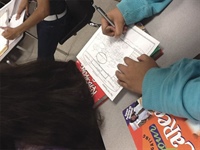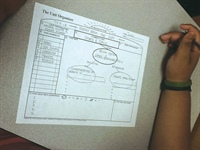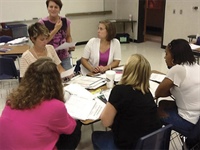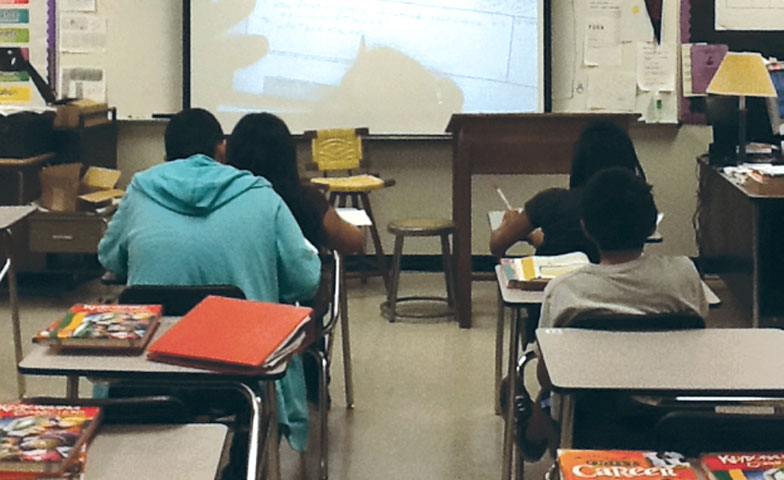More than 90% of Simon Middle School’s 620 students are economically disadvantaged, 95% are minority, 52% are English language learners, and 14% have special needs, so ensuring that all of its students are successful could be a challenge. But the school, located in Kyle, Texas, has been recognized for closing its student achievement gaps.
Four years ago, Simon Middle School, along with demonstration schools in five other Central Texas school districts, launched the Research-Validated Approach to Instruction for Secondary Excellence in Texas (RAISEup Texas) with whole-school implementation of the University of Kansas Center for Learning (KUCRL)’s Strategic Instruction Model (SIM). The implementation has drastically changed the achievement and learning outcomes of Simon’s students.

Content Enhancement Routines give students the tools to learn and teachers the tools to teach deep content knowledge.
SIM provided teachers at Simon Middle School with a planning process, known as SMARTER Planning, to study their content, analyze student learning difficulties, and implement what the program calls Content Enhancement Routines as a way to teach more strategically. In addition, the teachers use SIM’s Content Literacy Continuum, a comprehensive secondary literacy program that addresses district needs for research-based, robust content literacy application.
The school schedules courses for interventions, implements Content Enhancement Routines across all content areas, and embeds learning strategies in intervention classes and across content areas where appropriate. Most important, it allows students to focus on progressing on their own rigorous continuum by helping co-develop the learning experience with the teacher in each class.
Simon faculty have been trained in 10 of the 14 different Content Enhancement Routines provided in the SIM. The Content Enhancement Routines support teaching in several ways. They:
- Help teachers think about and organize information to make it more accessible to their students.
- Help teachers lead their students through an exploration of a topic.
- Help with teaching big ideas and concepts.
- Focus specifically on improving student performance.
Principal Matt Pope likes to compare a middle school student to a professional employee who has seven different bosses in one day. How could anyone be successful satisfying that many bosses? The way to do it is to provide a cohesive framework for accessing, teaching, and learning content. He says, “We are failing our kids when we give them seven different bosses at ages 10 to 15. Their brains aren’t developmentally ready for that. But we’ve been able to give students the consistent tools in every classroom to learn how to learn and teachers the tools to teach deep content knowledge.”
From Day One
On the first day of sixth grade at Simon Middle School, every student is introduced to a course organizer in each classroom. From P.E. to science to math, each course is taught using this approach. Think of the course organizer as a visual syllabus of the year. It outlines the journey the teacher and students will take together throughout the year. The big ideas, critical content, and important questions of the course are discussed. This gives the students a conceptual map of how the course will progress throughout the semester or year. And, it lets them know what questions they will be able to answer at the end of the course.
On the second day, sixth graders are introduced to the unit organizer, which outlines the curriculum to be covered. “The big idea of each unit is identified, and then tied back to the big ideas of the course,” Pope says.
A frequently used Content Enhancement Routine is the Anchoring Routine. This is an opportunity for students to ground a new concept in previous knowledge. For example, a teacher asks his students to compare a wire coat hanger to a vertebrate skeleton. Students most likely know what a coat hanger is, its properties, and what it does. Through the classroom discussion, students identify properties of the coat hanger:
- It holds coats.
- It helps retain the coat’s shape.
- It has a hook.
- It is wire.
- It lasts a long time.
- It bends.
- It gets rusty.
Then the conversation turns to vertebrate skeletons. Again, through the classroom discussion, students identify their properties:
- They are backbones that connect to arms and legs.
- They give the body shape.
- They can bend and return to their original shape.
- They last a long time.
Students are then asked to list the shared characteristics of the two items:
- There is a known shape to both items.
- They are known to shape something else.
- They are flexible.
- They are strong.
When new information is introduced (skeletons) using things that students already know (coat hangers), new information is anchored and the process of retention is enhanced because new information is attached to something that is familiar.
Students are then asked to construct a model using the new information they learned. This transfers the new knowledge into a hands-on learning experience for even deeper retention and understanding. Through this process, the teacher and students have co-created a learning experience. The teacher has become the learning facilitator or co-captain of the ship.
If an additional experience is needed to solidify the learning, the teacher may offer an article or a model for the students to study and ask them to pair-share, or he may give the class additional information about the learning experience.
In this process of cue–do–review, students are given explicit instruction, experience the new learning, and review what they have learned. Students then relate the new concepts back to the unit organizer and to the course organizer. This gives teachers a formative assessment of the student’s current knowledge. But the learning does not stop there for the teacher. Once the unit is complete, Simon teachers come together in professional learning communities to review their teaching strategies and bring a deeper understanding to their work.
Another example of a routine from the SIM toolbox is the Concept Comparison Routine, which is similar to the Venn Diagram. These diagrams ask students to compare and contrast two or more topics. The Concept Comparison Routine asks students to find the characteristics of concepts and compare them, and then categorize the characteristics, write about their findings, and extend their new understanding to another topic.
After students learn the steps of the routine, they are able to transfer this process to any issue they need to analyze in their lives. For example, if students are asked to compare vertebrates to invertebrates, they will:
- List characteristics.
- Group them into like and unlike.
- Create categories of characteristics.
- Write a sentence or two about the things they compared.
“If you are going to choose health plans, you are going to use this Concept Comparison Routine whether you understand the process or not. That is why the SIM approach is so powerful. This is a life skill that is learned in sixth grade,” according to Teri Clement, Simon’s SIM instructional coach.
Seeing Results
SIM helped bring the different content areas together through a common framework and with consistent tools for accessing content, teaching, and learning. In addition, according to Principal Pope, RAISEup Texas gave him “proof that our lower-performing students were catching up to higher-performing students because they were learning how to learn.”
“Even without teacher support, our former students are still using the learning strategies and routines they gained here at Simon Middle School,” Pope says. “What we have done is provide lifelong tools for students to ‘learn how to learn,’ and that is so much more important than numbers from an assessment.”
As a result of this work, Simon Middle School has fewer students who need Response to Intervention supports as they progress. Fifty percent of the students who start sixth grade enter below grade level. By the end of sixth grade only 25% of those students need support. By the end of eighth grade only a handful of students are receiving special services.

Learning strategies help students improve their reading skills and set goals.
SIM Learning Strategies help struggling students improve their content acquisition through targeted literacy skills. The 34 Learning Strategies focus on areas such as:
- Acquiring new skills, such as paraphrasing and word mapping.
- Remembering and studying information.
- Improving writing.
- Performing on tests.
Strategies also address personal interactions, community interactions, and motivation.
At Simon, 60% of the students who attended Learning Strategies classes moved to grade level in one year, making two to three years worth of gains in nine months.

Professional learning communities, job-embedded professional development, and leadership coaching provide necessary supports.
Extensive job-embedded professional development, professional learning communities, and leadership coaching are all necessary supports for successful whole-school implementation of RAISEup Texas and the SIM program. “The hardest thing about this process is breaking bad habits,” Pope says. “Adults changing their behavior can be a long process. On the other hand, because SIM has been researched extensively, I can ask this question: ‘How do you trust what you are doing is best for your students? What evidence do you have that the strategy you are using is going to help them retain new information?’ This question gives us a great place from which to begin our discussions,” he says.
With a focus on engagement, multiple learning and teaching approaches, and the strategies in RAISEup Texas, Simon Middle School has made a transformation. Everyone has a clear vision of how to learn. “I’m a better instructional leader because of RAISEup Texas. It has taught me how to be a better teacher of teachers. It has helped me change the lives of students,” Pope says.
| About RAISEup Texas
RAISEup Texas is a program led by E3 Alliance, a nonprofit regional education collaborative located in Austin, Texas. Developed five years ago based on extensive research, E3 Alliance, along with the University of Kansas Center for Research on Learning and the Education Service Center Region 13, deployed RAISEup Texas in six middle schools in Central Texas. The Meadows Center for Preventing Educational Risk was the external evaluator for the demonstration project. For more information on RAISEup Texas go to www.RAISEupTexas.org or contact E3 Alliance at info@e3alliance.org. |
Susan Dawson is the executive director of E3 Alliance. sdawson@e3alliance.org
Christine Moses is the CEO of Buffalo Cloud Consulting and a freelance writer. buffalocloudconsulting@yahoo.com
Published in AMLE Magazine, May 2015.
